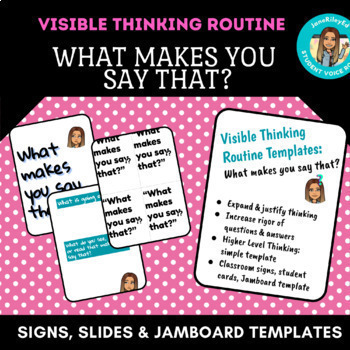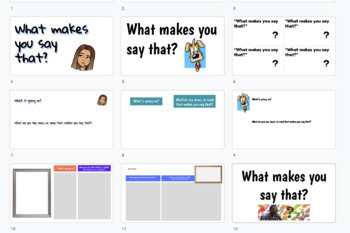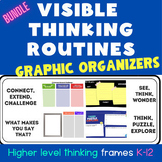Thinking Routine Templates: "What Makes You Say That?" explain justify thinking
- Google Slides™

Also included in
- Visible Thinking Routines are powerful higher level thinking questions & frames that can be used everyday in the classroom- over and over to elicit critical thinking and discussion!Higher Level Thinking prompts- by Harvard's Project Zero & Making Thinking Visiblesynthesize, & expand thinPrice $25.00Original Price $31.25Save $6.25
Description
The Visible Thinking Routine "What makes you say that?" has been the single most effective question I've asked in class (and PD!)
- Students expand their answers with a justification- from their thinking, or from something they see, heard, or read.
- Use these slides templates & posters as sign to hold up in discussions, for student participation cards, or interactive responses i.e. on Jamboard!
- Editable slides to adjust font or your own bitmoji or school mascot
- 15 slide options/ variations
- Close reading, speaking & listening, rigorous discussion, justification of thoughts and ideas, text based evidence...
This set includes 15 graphic organizers, posters, question cards
Please follow me for more engaging resources- and reach out anytime with feedback! Thank you! JaneRileyEd@gmail.com
--------
From Harvard's Project Zero re: What Makes You Say That? Visible Thinking Routine
A THINKING ROUTINE FROM PROJECT ZERO, HARVARD GRADUATE SCHOOL OF EDUCATION
Purpose: What kind of thinking does this routine encourage? This routine helps students describe what they see or know and asks them to build explanations. It promotes evidential reasoning (evidence-based reasoning) and because it invites students to share their interpretations, it encourages students to understand alternatives and multiple perspectives.
Application: When and where can I use it? This is a thinking routine that asks students to describe something, such as an object or concept, and then support their interpretation with evidence. Because the basic questions in this routine are flexible, it is useful when looking at objects such as works of art or historical artifacts, but it can also be used to explore a poem, make scientific observations and hypotheses, or investigate more conceptual ideas (i.e., democracy). The routine can be adapted for use with almost any subject and may also be useful for gathering information on students’ general concepts when introducing a new topic.
Launch: What are some tips for starting and using this routine? In most cases, the routine takes the shape of a whole class or group conversation around an object or topic, but it can also be used in small groups or by individuals. When first introducing the routine, the teacher may scaffold students by continually asking follow-up questions after a student gives an interpretation. Over time students may begin to automatically support their interpretations with evidence without even being asked, and eventually students will begin to internalize the routine. The two core questions for this routine can be varied in a number of ways depending on the context: What do you know? What do you see or know that makes you say that? Sometimes you may want to preceded students’ interpretation by using a question of description: What do you see? or What do you know? When using this routine in a group conversation, it may be necessary to think of alternative forms of documentation that do not interfere with the flow of the discussion. One option is to record class discussions using video or audio. Listening and noting students’ use of language of thinking can help you see their development. Students’ words and language can serve as a form of documentation that helps create a rubric for what makes a good interpretation or for what constitutes good reasoning. Another option is to make a chart or keep an ongoing list of explanations posted in the classroom. As interpretations develop, note changes and have further discussion about these new explanations. These lists can also invite further inquiry and searches for evidence. Other options for both group and individual work include students documenting their own interpretations through sketches, drawings, models and writing, all of which can be displayed and revisited in the classroom. This routine is adapted from Visual Thinking Strategies (VTS), developed by Philip Yenowine and Abigail Housen. See: Yenawine, P. (2013). Visual thinking strategies. Cambridge, MA: Harvard University Press.




